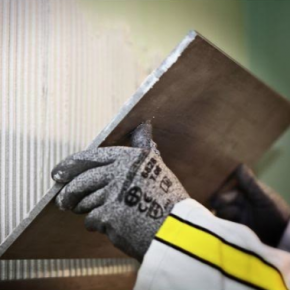
Saint Gobain Weber talks tiling over tiles
When tackling a refurbishment project, it can be a pain to remove the existing tiles before laying new ones, adding time and effort to the project. So can you tile over tiles? The answer is yes, but there are a few things to keep in mind when tiling on top of existing tiles. Here’s Saint Gobain Weber’s advice…
1. Pick which tiles to use
When tiling onto walls, it’s important to consider the surface behind the tiles and how much weight it will be able to carry. The most common background for tiles is plasterboard which can hold around 32kg/m², allowing for 3.5kg of adhesive and grout, and 28.5kg of tile per square metre.
Skimmed plasterboard, however, can only take around 20kg/m², so you’ll only have an allowance of 16kg/m² for tiles after adhesive and grout. With this in mind, consider the existing tiles – if the old tiles are quite heavy already, this will limit your choice of new ones. If you are looking to use larger, heavier tiles, you will likely need to remove the old ones first.
2. Prepare existing tiles
It’s important to first check that the existing tiles are well-bonded to the substrate. If not, the new tiles could cause the old ones to come loose. If the old tiles are suitably fixed, you can now proceed to preparing them for the job. If not, unfortunately, they’ll need to be removed.
Before beginning, check that the tiles are level. A grinder must be used to flatten any areas which stick out from the rest of the
surface. If the existing tiles have been sealed, the sealer will need to be removed for the adhesive to stick to the tile. Finally, the existing tiles need to be cleaned thoroughly and all dust removed. This is a crucial step as the new tiles may fail to adhere if the old ones aren’t suitably cleaned.
3. Fix new tiles
When the surface is ready for tiling, spread a layer of flexible adhesive such as weberset SPF or weberset rapid SPF onto the
surface of the existing tiles. If the new set of tiles are particularly large or are stud-backed, an additional layer of adhesive on the back of them may be required.
If tiling onto a heated floor, a flexible tile adhesive is a must to allow for expansion and contraction of the surface beneath the
tiles. A quartz tile will require an ultra-flexible S2 tile adhesive, such as weberset pro lite – rapid.
4. Finish with grout and sealant
Finish the job by filling the joints with a suitable tile grout such as weberjoint premium which is available in a range of 18 colours. Use weberjoint silicone sealant (colour-matched to our full range of grout colours, as well as clear option) to seal the edges.
Latest news

21st February 2025
ASSA ABLOY EMEIA: Save valuable time and money with a seamless switch to programmable digital keys
In 2025, access management can be a whole lot easier. By making access part of their digital processes, businesses can put time-consuming key management and the cost of changing the locks firmly behind them. Making this switch is a lot easier than many people think, as ASSA ABLOY explains here…
Posted in Access Control & Door Entry Systems, Architectural Ironmongery, Articles, Building Industry News, Building Products & Structures, Building Services, Doors, Facility Management & Building Services, Health & Safety, Information Technology, Innovations & New Products, Retrofit & Renovation, Security and Fire Protection
21st February 2025
Showersave supports industry leaders in addressing Part L and Part G regulations
Showersave has sponsored and participated in a recent Building Insights LIVE roundtable on ‘Water & Energy Saving Innovations in New Build Housing’.
Posted in Articles, Bathrooms & Toilets, Bathrooms, Bedrooms & Washrooms, Building Associations & Institutes, Building Industry Events, Building Industry News, Building Products & Structures, Building Regulations & Accreditations, Building Services, Exhibitions and Conferences, Interiors, Pipes & Fittings, Plumbing, Retrofit & Renovation, Sustainability & Energy Efficiency
21st February 2025
GEZE: The importance of Specifying High Quality Door Closers on Fire Doors
Andy Howland, Sales & Marketing Director at GEZE UK, discusses why specifying high quality door closers on fire doors is important…
Posted in Access Control & Door Entry Systems, Accessibility, Architectural Ironmongery, Articles, Building Industry News, Building Products & Structures, Building Regulations & Accreditations, Building Services, Doors, Facility Management & Building Services, Health & Safety, Posts, Restoration & Refurbishment, Retrofit & Renovation, Security and Fire Protection
21st February 2025
Insight Data achieves ISO9001 recertification with zero non-conformities
Leading industry data specialist, Insight Data, has successfully achieved the prestigious recertification for ISO9001 with zero non-conformities for the fourth consecutive year.
Posted in Articles, Building Industry News, Building Regulations & Accreditations, Building Services, Information Technology, Research & Materials Testing
 Sign up:
Sign up: